SMALL TOWN TO BIG TIME, DUGOUTS TO FORUMS
THE STORY OF CARTER AND THE CUP
His story has now been told by sports reporters throughout the hockey world: the unlikely tale of a determined athlete, never drafted, and overlooked by NHL teams until late in the 2016-17 hockey season when the Penguins plucked him from the minors at the advanced age of twenty seven and they won the Holy Grail of Hockey.
Carter remains furiously loyal to his small town roots. In an interview (Stan Neufeld) with Carter he stated “Upon winning the cup I wanted to do something special for Sexsmith and Grande Prairie. I grew up in this community and it will always be home. You only get the cup for so long and I wanted it to be here.
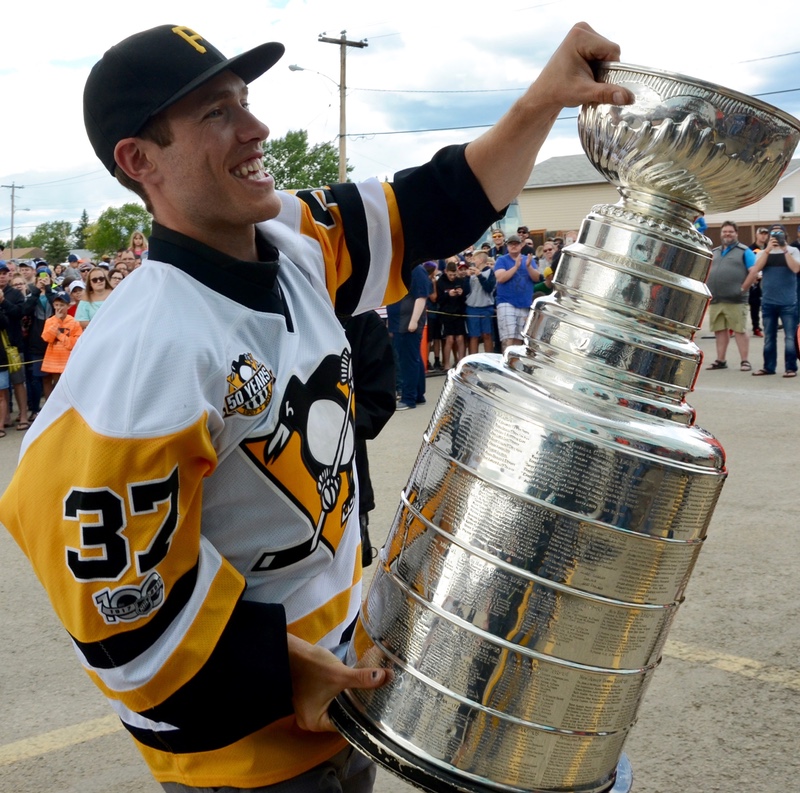
Carter Rowney shows off the cup. Photo by Stan Neufeld
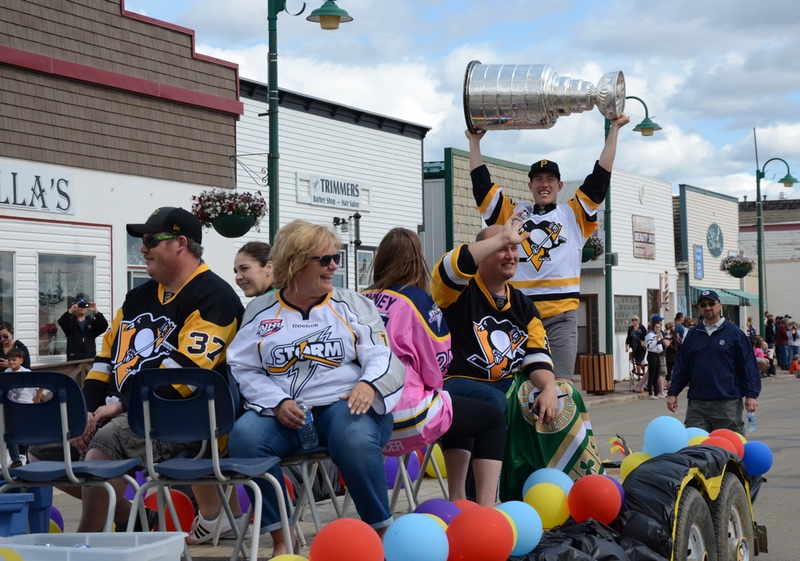
Rowney family parade float. Photo by Stan Neufeld
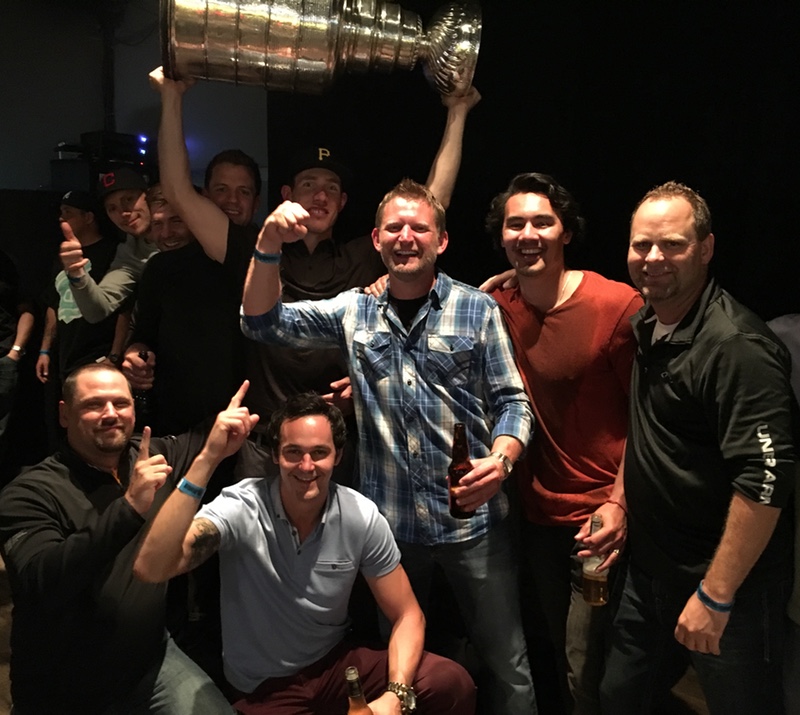
Carter with former teammates and coaches including: Marc Beaudoin, from left, kneeling, and Morgan MacLean.
Tanner Fritz, back from left with thumbs up, Blake Clement, Mark Stojan, Carter Rowney, Mike Vandekamp, Dennis Rix, Kelly Coulter and Blaine Bablitz. Photo courtesy of Kelly Coulter
My elder brother Ron remembers Sexsmith in the 1940’s – the era of GP Hockey Legend Duke Edmundson who was born in Sexsmith. The population was approximately 300. Heading north on Highway Two from Grande Prairie a long line of grain elevators - eight of them came into view. The stately structures stood out like sentries along the Northern Alberta Railway’s (NAR) ribbon of steel that carried grain from Sexsmith to markets throughout the world. It was the “Grain Capital” of the British Empire.

Sexsmith Grain Elevator. Photo by Stan Neufeld
I’m not familiar with the Rowney’s early family history and details concerning their move to the Peace River country but Carter reports that he spent the first ten years of his life on a farm in the Sexsmith area. He says nothing about milking cows or wrestling horses into their harnesses in the early morning hours but he does lay claim to having operated a combine. Surrounded by farm machinery while he was growing up I would be willing to wager that Carter did not have to enroll in a driving school in order to obtain a Driver’s License. I would make a further wager that growing up on a farm contributed to Carter’s’ strength and his work ethic as an elite hockey player. Puck control and winning battles for the puck in the face off circle and along the boards is a hallmark of Carter’s hockey game. That requires superior strength and is due in part to muscle development that he can attribute to performing daily chores on the farm. Even on a mechanized farm a great deal of manual labour and physical work is required – like shoveling grain.
In an interview with Carter (Stan Neufeld) he summarized his recollection of growing up on the family farm as follows: “My family farmed when I was young. I was raised on the farm until I was 10. Then, the oil and gas industry was really booming and my family got into that. My Uncles and Aunts still farm. Those are the main industries up there, farming, oil and gas.” Asked if he enjoyed growing up on a farm Carter responded, “It was cool. There were a lot of little things you got to do around the farm to keep you busy. I remember cleaning granary bins - that was rotten. That was one of the first things I had to do as a kid. It was rotten and the pay wasn’t the greatest from my parents. But it was good to grow up on a farm. I got to drive the combines a little, but I was young so I didn’t run them that much. I was more of the errand boy.”
Today in Sexsmith’s town centre the old boardwalk has been replaced by cement curbs and the once gravel covered main street has been paved.

Sexsmith main-street. Photo by Stan Neufeld
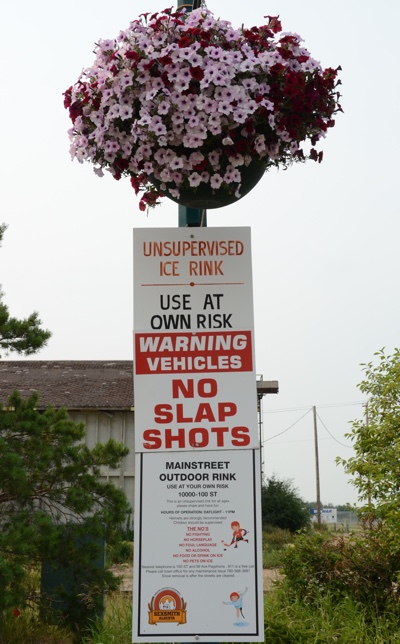
Only in a small town like Sexsmith would you see a sign on main-street like this one. Photo by Stan Neufeld
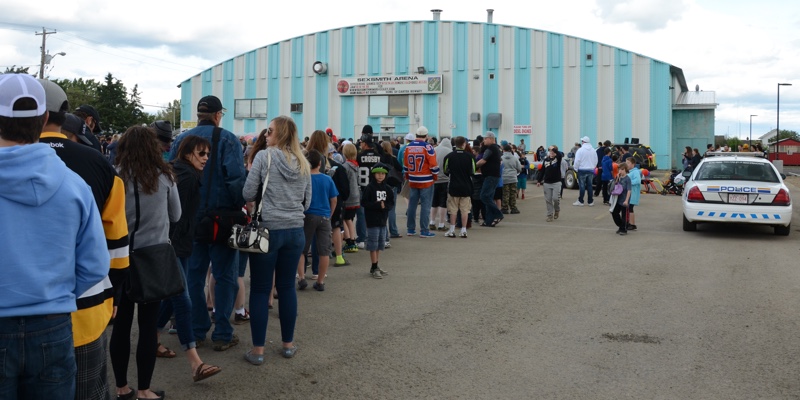
Fans lined up in front of Carter Rowney’s hometown arena for hours in hopes of getting an autograph and a photo with the NHL star. Photo by Stan Neufeld
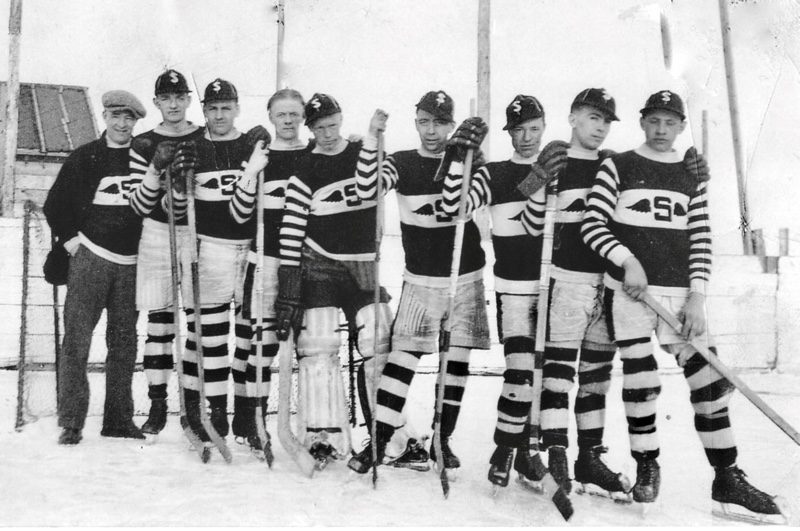
The “S” on the sweaters stands for Sexsmith, the neighbouring community that competed against Grande Prairie in one of the early post war leagues. Frank Edmundson (father of Hockey Legend Duke Edmundson who played in the NHL with Toronto and Montreal) pictured here, without a cap, played on the first ever Grande Prairie Red Devil team in the 1930’s. Notice the short canvas hockey pants and lack of shoulder and elbow pads. Photo courtesy of Bryan Edmundson
Sexsmith is developing a heritage museum worth visiting that features a growing collection of buildings and historical artifacts to remind us of conditions faced by Sexsmith pioneers. Hopefully the Museum will include reminders of hockey history in Sexsmith that is older than the town itself. It predates 1929 when Sexsmith gained village status. The town did not have a senior team when I (Ron Neufeld) was playing minor hockey in the old Wapiti Arena in Grande Prairie in the 1940’s and 50’s but they had a very respectable junior hockey team. Clayton, Kris and Carter were not the first trio of brothers to “light it up” for hockey in Sexsmith. In the 1940’s the Gudryn Brothers: Carl, Ernie and Willie were the backbone of the team. I suspect that they were all possible candidates for careers in hockey but Sexsmith was not included on the itineraries of NHL scouts.
Carter and his brothers experienced a period of transition from conditions in the forties of Duke Edmundson and the Gudryn Brothers to Sexsmith as we know it today. During that transition two related issues stand out: one – the effect on them of growing up in a small town and two – for lack of better terms, the formalization or modernization of the game of hockey. As it relates to modernization, hockey is no longer the only game in town during the winter. Many activities compete for the attention of young people. Also, the facilities for playing hockey today are not as accessible as they were when there were backyard rinks and ponds. There were no admission fees for backyard rinks and ponds and no rigid hours except for Mom’s mandate, “Get home before dark.” Today playing hockey on outdoor ponds is uncommon and one will not see kids on the ice wearing Sears and Roebuck catalogues held in place by binder twine to protect their shins. It is unlikely that they even know what catalogues and binder twine are. Hockey is much more formalized and the cost of equipment and ice time prevents many children from playing.
Concerning the impact of growing up in a small town, research has been conducted supporting the claim that growing up in a small town is an advantage to kids that aim for a career in sport.
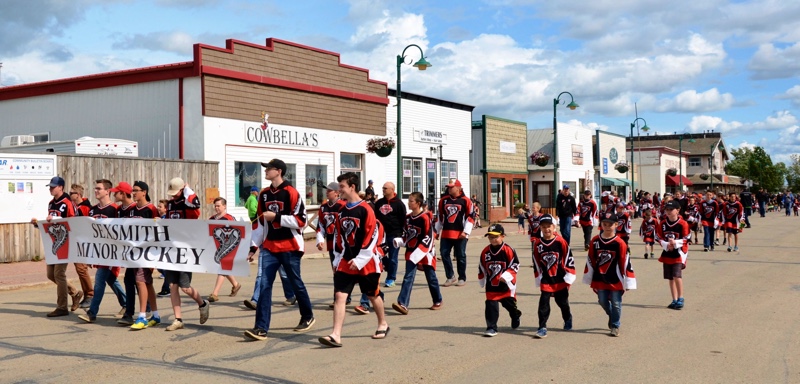
Minor Hockey players, coaches and parents show up big time to support their hometown hero. Photo by Stan Neufeld
So – what are factors that contributed to Carter’s journey from small town Sexsmith to the NHL? It seems to me that all of the elements discussed above were elements in Carter’s development and contributed to his successful bid to play in the NHL: identifying with local role models, ready access to ice, participation in various sports activities and an abundance of free ice time without adult supervision. He was not over coached. While Carter acknowledges the benefits he experienced from unstructured free play while growing up in Sexsmith he gives credit to the guidance he received from coaches as he was developing. “I remember every one of my coaches and they all played a huge role in my development both on and off the ice. One of my cousins, Darren Hawkes and Curt Trydal were among my coaches back then.” (Stan Neufeld interview).
Colin Miller was Carter’s first coach. Upon moving to Sexsmith in 1989 Colin immediately became involved with hockey teaching kids to skate and coaching at the peewee level. Carter’s relationship with Colin is a “text book” illustration of a child, while playing hockey in a small town identified a role model from the local community and from him learned important life skills, established a life long relationship and in the process laid the foundation for his career in sports. Colin’s son and Carter were friends and both were interested in hockey. The local rink was not always available when the kids wanted to play so Colin constructed a rink in his backyard; a rink that even had boards. On this backyard rink and on the dugout described by Kris, Carter refined his skating ability and acquired his very basic hockey skills. Concerning Carter, Colin reported, “He was easy to coach - of all the kids he was the easiest. I would suggest this or that to him and he would be all over it. He had exceptional desire. He was amazing and would try anything I suggested. He was always willing to try something new.” Important elements in Colin’s coaching agenda was to teach players to respect their team mates, be on time, dress appropriately and when you have your work clothes on be ready to work. These are life skills not hockey but we throw in some hockey just for fun.” (Stan Neufeld interview),
Dale Collins, a cousin, Darren Hawkes and Curt Trydal were other minor hockey coaches in Sexsmith that Carter says were instrumental in his early development both as a person and as a player and during this period playing with his older brothers was especially helpful. Carter reports that it was Curt who convinced his parents that upon reaching his teens it would be to his advantage to enroll in Grande Prairie’s minor hockey program as a second year bantam. With his Mother as the chauffeur this decision involved frequent trips to and from Grande Prairie along with games and tournaments as far away as Edmonton, Calgary and Vancouver. “In Grande Prairie I played with a team called the Calgary Dynastars, This is where I met some of my lifelong friends like Dennis Rix, Tanner Fritz, and Mark Stojan. They remain good friends to this day.” Carter was coached by Kelly Coulter for five years and for two years by Mike Vandekamp while playing with the GP Storm in the Alberta Junior Hockey League. “I would like to mention Kelly Coulter who had an impact on my career.”
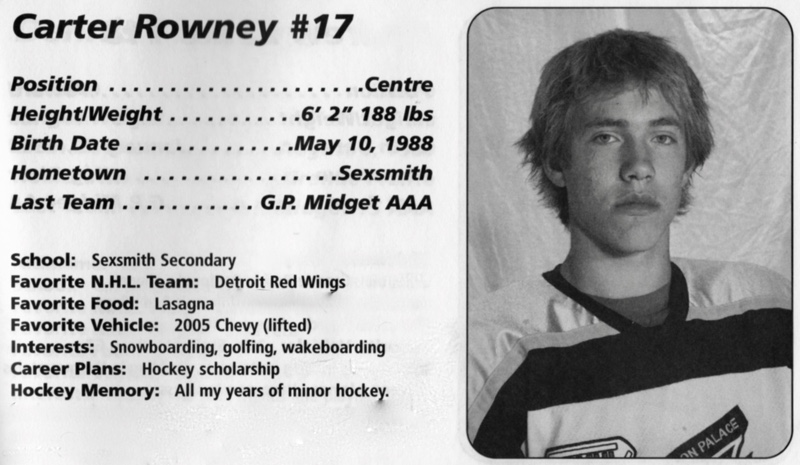
Carter Rowney Midget Storm AAA player profile. Photo courtesy Grande Prairie Minor Hockey
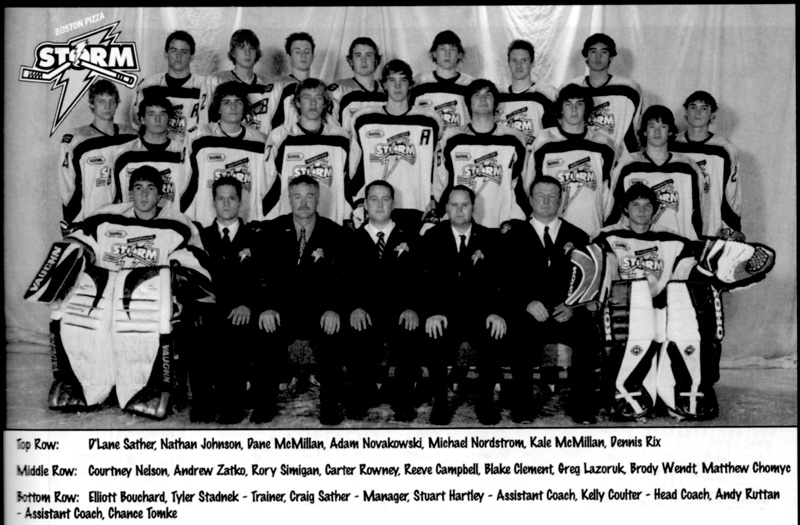
Midget AAA Storm 2005-2006. Photo courtesy Grande Prairie Minor Hockey
Mike Vandekamp coached the Storm for four years and under his leadership Grande Prairie won the Alberta Junior Hockey League (AJHL) Championship in 2009. In an interview with Stan Neufeld Carter stated, “I had a few good years with the Storm and my coach, Mike Vandekamp really helped my development as a player. Among my best memories here is when we won the Alberta Junior Hockey League in 2009. I still like talking about that. This was a huge accomplishment not only for myself but also for this team of homegrown kids: Blake Clement, Mark Stojan, Dennis Rix, Morgan MacLean and Tanner Fritz.”
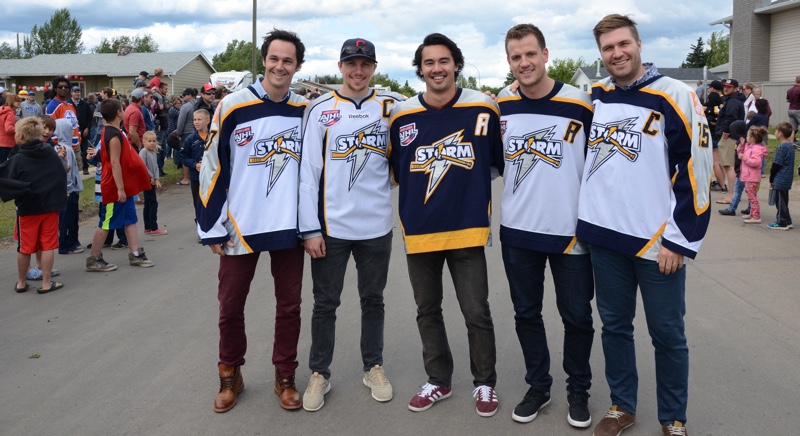
Storm alumni Morgan MacLean, left, Tanner Fritz, Dennis Rix, Mark Stojan and Blake Clement were participants in the parade. Photo by Stan Neufeld
Heading into the championship series coach Vandekamp knew that a superior performance from Carter was essential if the Storm was to win. Furthermore it was Vandekamp’s contention that Carter did not know how good he was. In a conversation with Carter prior to the series the coach shared his perception that Carter was the key to their winning and he challenged him with the responsibility of carrying the weight of the team’s success on his young but sturdy shoulders. Cater rose to the occasion – he had an outstanding series – his team came home with the trophy and Carter was the playoff series MVP. It was Vandekamp’s belief that “Sometimes you have to force a player into making him realize how much of an impact a person can actually have on a game.” That’s a “catch twenty two” for an individual like Carter with a genuine and admirable unassuming and humble nature.
Assessing Carter’s hockey skills, Vaandekamp stated, “His on-ice intelligence is amazing. He’s just a real smart hockey player. As you climb up the hockey ladder your ability to play within the structure and within the team concept is a huge attribute. He’s always had that. He’s got smarts and is a true 200-foot player. He’s as good a player without the puck as he is with the puck.” It was approaching Christmas in 2009 that Carter received word confirming his coach’s confidence in him: he was offered and subsequently accepted an Athletic Scholarship to play hockey for the University of North Dakota. Reflecting on Carter’s career former coach Coulter concurred that the “NCAA was a perfect route for him.” (Stan Neufeld interview.)
Dennis Rix is currently Assistant Coach and Business Manager for the Storm. Dennis and Carter are former teammates and lifelong friends. In an interview with Dennis (Stan Neufeld) he reported “We were just kids in novice minor hockey but I remember playing against Carter in Sexsmith. We hated playing against him because he was so good and hard to play against but I loved playing with him once we became team-mates. Regarding our Storm Championship team in 2009 – it was pretty cool. We played a round of golf on July 13 and then went out for dinner where we had a chance to talk about it. You can’t compare it to the Stanley Cup but winning the AJHL is still one of our fondest memories. Looking back at old photos we see Carter and me taking a knee beside the cup and getting our medals.”
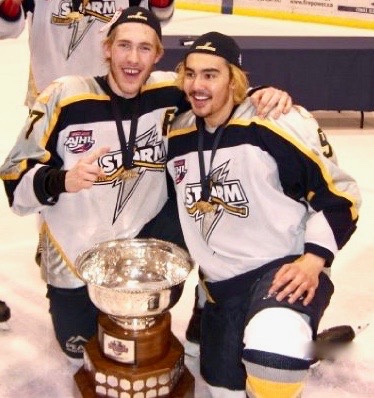
Carter Rowney and Dennis Rix with the 2009 AJHL championship trophy. Photo courtesy Grande Prairie Storm
After playing with the Storm Dennis played four seasons with Michigan Tech and earned a Bachelor’s degree in Business Management. From Michigan Dennis journeyed to Scotland where he played one year with the Edinburgh Capitals of the Elite Ice Hockey League while obtaining an MBA before returning to Grande Prairie where he continues to coach and has taken the reins of the Business Office.
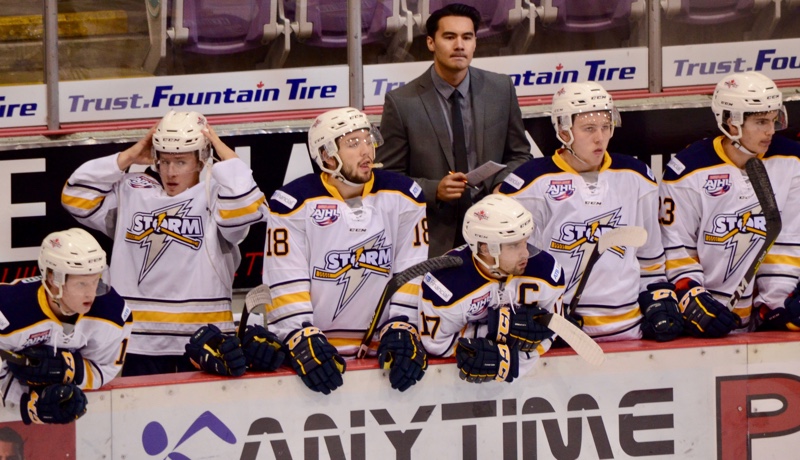
Storm Assistant Coach Dennis Rix behind the bench. Photo by Stan Neufeld
Reminiscing with Stan Neufeld about his college hockey career Carter stated, “Grande Forks is not overly large and much like Grande Prairie including similar weather. I liked it there and felt at home right away. We had a great arena with unbelievable fans. We filled the rink every game with 12,000 fans.” While playing Collegiate hockey Carter earned a degree in Managerial Finance and Corporate Accounting. Overshadowing all of Carter’s academic and athletic achievements in sports and in the classroom was his connecting with and marrying Danielle Luetzen. Danielle “lettered” in volleyball at UND and leading up to the 2017 NHL playoffs Anders, their firstborn came along. You can bet that Carter’s marriage to Danielle, the birth of Anders and winning the Stanley Cup are three events that will be forever etched on the Carter Rowney family calendar.
Carter’s first performance as a professional was in 2013 with the Abbotsford Heat of the AHL. He played just four games with the Heat before becoming Pittsburgh Penguin property – first with the Wheeling Nailers and then with the Baby Penguins located in Scranton/Wilkes-Barre Pennsylvania. Three years later on January 31, 2017 at the age of 27 Carter made his NHL debut in a game against Nashville and on February 4 in a game against St. Louis he recorded his first NHL point. In game six of the 2017 Stanley Cup finals the Penguins with Carter Rowney on their roster defeated the Predators and Carter joined his teammates in hoisting the Stanley Cup. Glued to TV sets and cheering him on were Carter’s numerous fans in Sexsmith and Grande Prairie. His family was ringside at Game Six to share his excitement.
It should be noted that not everyone in Carter family circle was impressed on the day Carter and his Penguin teammates hoisted the cup. One person snored through all of the excitement. It was Carter’s nine-week old son Anders who is pictured - sound asleep in the Stanley Cup between the watchful eyes of his proud parents. Years hence Anders will have the opportunity of making up for his lack of awe on that day. Hockey is not a gentle sport and looking ahead the time will come when Carter’s career as a player will end and Anders will see the toll his Father’s body has taken from delivering and absorbing countless body blows. Predictably Anders will be interested in hearing his Dad’s story and his heart will swell with pride when he looks at the infant in the cup and as his Dad recounts his hockey adventures.
Stan Neufeld asked Carter if he would like his son to play hockey. Carter answered in the affirmative. “I love hockey and the sport so would love it if he chooses to play but it’s whatever he wants at the end of the day. If he chooses to play hockey I will be pressing for him to represent Canada but at the end of the day I just want to be a proud parent.” If Anders elects to play hockey it will not be a function of parents living their dreams through a child. It is clear from interacting with Carter’s parents that Cater’s career path was of his choosing. They provided the support along the way but Cater’s decision to pursue a career in hockey was his choice without manipulation from his parents.
Carter’s constant and steady performance as an unassuming reliable two-way player is a reminder to hockey fans and hockey players everywhere that defense wins games. Offensive ability and flashy moves attract a great deal of attention and adulation from many fans and the media. However, connoisseurs of the game, coaches and goaltenders in particular are more impressed by the steady consistent hard work of a player who can be relied upon to place the team and the well-being of fellow players ahead of his/her own interests and that translates into goal prevention first. Carter’s skill in the face-off circle throughout the playoffs was an important part of Carter’s contribution to the Penguin winning ways in the playoffs. Kelly Coulter - the 10,000 puck drops that left tattoos on your shins paid off. Carter - rumour has it that you are being encouraged to purchase a home in Pittsburgh and I see your name on the 2017/18 Penguin’s 2017/18 roster. CONGRATULATIONS!
Carter readily acknowledges that his journey has not always been easy. “My hockey career has been a long road, with ups and downs. I kept my head down, kept pushing forward and believed in myself. Good things happen when you put in the time and effort and believe in yourself. For young kids coming up - they have to believe anything is possible. The key is to work hard, deal with the ups and downs, so it’s not always going to be easy. It’s never an easy road no matter what you do in life. It`s how you handle it, it’s about pushing hard, learning from mistakes and striving to be better regardless of the job.” (Stan Neufeld interview).
Carter - your place among the best hockey players in the world is well deserved and we – your fans in Sexsmith and Grande Prairie cheer you on.
Stan Neufeld
Grande Prairie Hockey Legends is researched, written and presented by Stan and Ron Neufeld